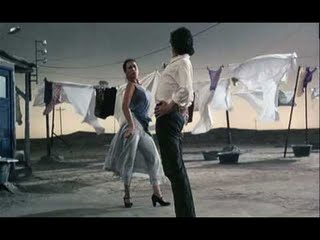Azar - The Beauty Of Randomness
Tuesday, December 29, 2009

azar.
(Del ár. hisp. *azzahr, y este del ár. zahr, dado1, literalmente 'flores').
1. m. Casualidad, caso fortuito.
Diccionario de la Real Academia Española
Azar
La palabra azar viene árabe الزهر (az-zahr) que significaba primero "flor" y luego se empleó para la marca que daba la suerte en la taba, que era la rótula de un mamífero mediano, como una oveja o una cabra. En la taba, antecesor del dado cuadrado, se marcaba con una pequeña flor uno de sus lados, que era el que daba la suerte. En el juego que en árabe y otras lenguas de Oriente se llamó نرد (nard), en español tablas reales, en francés tric-trac y en inglés backgammon, el dado se llama زهرة النرد (zahrat an-nard), literalmente "la flor de las tablas reales". El uso de الزهر (az-zahr) con el significado de dado hizo que en castellano se introdujera el arabismo azar con el significado del latín alea. (ver aleatorio).
From el origen de las palabras
This is about randomness and the beauty that I have found through it. Because it is about randomness I feel I can justify my going into different directions. Not a couple of months ago I read in my NY Times, in a business article, about the decline of magazines. The writer reflected on the space constraints of magazines and especially in relation to ad content. The writer went on to make a statement that registered in my brain. It was something like, “Space in magazines is limited, on the web the real estate [my italics] is infinite.” With that in mind and considering that I have not editor I will do so as I please and write to whatever length this finally ends up in.
For years I have absolutely despised flamenco in all its forms. I cannot stand the music, gypsies sitting on small stools playing what passes as dramatic music while other men and women clap their hands. I cannot abide by the stamping of feet on tables (as seen in Hollywood films about Mexico. Curiously early American directors equated flamenco with Mexico) or the playing of castanets. I loathe them.
Part of my reason for disliking flamenco I can squarely place on the shoulders of my snobbish mother who deprecated Spanish music. She told me that the best songs about Spain had been written by Mexican composer, Agustin Lara (one version of La Malagueña) of by Cuban Ernesto Lecuona (the other better known Malagueña). Se further cited Edouard Lalo’s Opus 21 in D minor Symphonie Espagnole written for Spanish virtuoso violinist Pablo de Sarasate. She would end her argument telling me that Rimsky Korsakov’s Capriccio Espagnol sounded more Spanish than most Spanish music. She did not have to tell me about Bizet’s opera Carmen to put the nails on the Spanish coffin. I eventually agreed with her in 1961 when I my new craziness for American jazz I bought Miles Davis’ Sketches of Spain. If it was Miles Davis it had to be good.

I hated the first track on my record which was Joaquín Rodrigo’s Concierto de Aranjuez. I refuse to listen to it to confirm here my suspicion that you can hear castanets in it. The other tracks I learned to like and they have grown in my estimation through the years. But soon after Sketches of Spain you could hear versions of Rodrigo’s composition with solo clarinet, bass saxophone, voices and probably even with a kazoo accompaniment with the Swingle Singers. In Spanish when you really don’t like something you say, “No me gusta ni en pintura.” Or I don’t like it even as a painting. The Concierto de Aranjuez is up there with the theme song from Around the World in 80 Days and Doctor Zhivago’s theme Lara. I loathe all three.

In the 80s Vancouver had a renaissance of Greek restaurants. My wife’s favourite was Orestes. In these restaurants you were destined, no matter how you avoided it, to see a belly dancer which in my mind (I will cite here my ignorance on all things flamenco) was flamenco’s poor cousin via the gypsies that came from India. To make it all worse these belly dancers replaced castanets with little thumb metal devices that made a noise that would pierce into my head and produce an instant migraine without having to indulge in retsina. I dislike retsina as much as I dislike feta cheese and calamari. If I went to Greece I would live solely on olives (I love them) and the Greek version of that Italian concoction called pizza.
Sometime in the middle 90s before the local business magazine Equity ceased to publish, its publisher Ronald Stern gave one of his celebrated Christmas parties. To my horror the entertainment was to be a flamenco singer and dancer. The dancer Jocelina, see below, left, entered like a hurricane, with a shockingly black head and a body to die for. When she spotted me she winked. I immediately recognized her as a former habitué of that establishment on the corner of Main and Powell. As a blonde I had known her as Jocelyn and I had photographed her as a belly dancer. She proceeded to slithering around in a most graceful way. This she did to the singing of a man who was telling us a mournful tale of loss. A mournful tale of loss it was, to those who did not understand Spanish! Rosemary and I were trying to control our laughter:

Rich men shave with warm water. I am a poor man and I must shave with cold water. Alas I am a poor man and must shave with cold water. This is so unfair, so unfair.
He repeated that as a Gillette-like mantra.
My second thoughts on my hate of all things flamenco and the nether regions of the belly occurred when I saw Sarita, above, left, the belly dancer. She had formerly been a flamenco dancer. She was from Puerto Rico, she spoke Spanish and looked like the most beautiful Gypsy I had ever met in my life. I wasn’t the only one who had fallen for Sarita’s charms.
Alex MacGillivray, the restaurant writer for the Vancouver Sun wrote a review at the Kilimanjaro ( in Gastown) in which he did not mention the food once. His piece was all about Sarita!
I photographed Sarita, and, no matter how inexperienced I might have been, her pictures were some of the most overtly erotic I have ever taken. I found that my best recourse was to avoid her and to swear a life free of castanets, flamenco, stamping on floors and in particular that tongue slapping noise that belly dancers make that propels me to pull my hair. I have not seen Sarita since.
One potato, two potato, three potato, four.
Five potato, six potato, seven potato, more.
(Then the person would remove the fist on the word "more" and the game
would begin again.
Eenie, meenie, meinie, moe
Catch a niger[ that’s how I learned it in Buenos Aires in the 40s] by the toe
If he hollers
let him go
Eenie, meenie, meinie, moe
The Spanish version (I first heard it in Mexico) of the above youthful study into randomness is the much more satisfying:
De tín marín
de do pingüé,
cúcara, mácara, títere fue.
Yo no fui;
fue Teté.
Pégale, pégale
que ella fue.
But since the above are used to randomly choose something (two teams to play soccer at recess, is an example ) there is a purpose to that sort of randomness that is not subject to the vagaries of a more unsettling kind like leaving home and forgetting to lock the door. You remember, you get out of the car and lock the door. You drive off and, blocks away, you get into a fender bender. “Why did I have to forget to lock that door…?”
The word random in English to me has a mathematical ring to it. It brings to my mind Einstein's famous quote, "God does not play dice with the universe." The word is almost neutral unless I make the connection with "random violence" or "random killing". Then the word has a more sinister tone to it. In Spanish the expression is “al azar”. The word azar comes from the Arabic and originally it had to to with a knuckle bone from a sheep on which you would paint symbols including a flower (azhar is Arabic for flower) and play an ancient game which eventually let to dicea and other games of chance. To further make that word azar so beautiful, it was used by the Spaniards exclusively to name the white flowers of citrus fruits. Before Odorono came into Spanish life, agua de azhar, or citrus flower water hid the smells of infrequent bathing.
Randomness has changed, of late, a lot of my prejudicial perception on taste in the arts. It was the randomness of looking for movie DVD’s at the man branch of the Vancouver Public Library (Videomatica I now inform you that I will be spending less money at your establishment) that led to my current conundrum (not much of one, as I will admit that I have suddenly changed my mind) on flamenco.

At those stacks I found Spanish director Carlos Saura’s, right, Amor Brujo, 1985, (third of the trilogy that was preceeded by Blood Wedding, 1981, and Carmen, 1983). I decided to give it a go as I had seen previously one of the best films ever, Saura’s Goya in Bordeaux, 1999, and I think that his Tango, 1998, is the finest film ever made about Argentine tango.
Amor Brujo (based on the ballet by Manuel de Falla which I saw with Rosemary and my two granddaughters last Saturday) begins with one of the most remarkable and long tracking shots that would give Hitchcock a jealousy of indigestion. The dancing is superb and there is not one castanet to bee seen anywhere. The set is a huge car dump with an earthen floor. There is no zapateo (
foot stamping).

The main protagonist, Antonio Gades (photo above, right by Lorenzo Cebrian, is one of the most strikingly beautiful men I have ever seen. His partner, Cristina Hoyos, below centre in as still from Amor Brujo, is not as beautiful as a third girl, Laura del Sol, bottom right with gades, also in the cast. Rebecca asked me why this was and I had to explain that Saura did not cast actors because they were actors or even good looking actors. He preferred to cast very good dancers as actors regardless of their looks. This I confirmed when I found out that Gades(seen in all pictures here and lifted from Google images) was the most noted flamenco dancer of his generation, that he was the director of the National Ballet of Spain. Gades choreographed all the numbers of the trilogy. Cristina Hoyos’ curriculum credits were as good.


After this film (which Rebecca enjoyed and Rosemary commented, “The Spanish is so brief and so easy to understand.”) I have taken out the remaining films of the trilogy at the Vancouver Public Library! We are set for a Saura Saturday flamenco marathon.
I just might look for Sarita and see what I can do with my camera to capture a dance which I have suddenly come to understand thanks to Saura and the help of that wonderful randomness of the stacks of our Vancouver Public Library. I am certain that if my mother had ever seen any of these films her respect for real Spanish music might have grown. Luckily it wasn't too late for me to change my mind.
no castanets and no foot stamping with Antonio Gades and Cristina Hoyos






